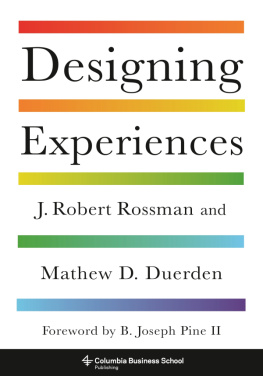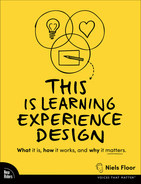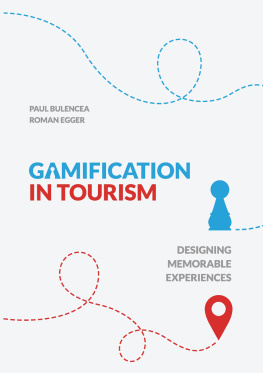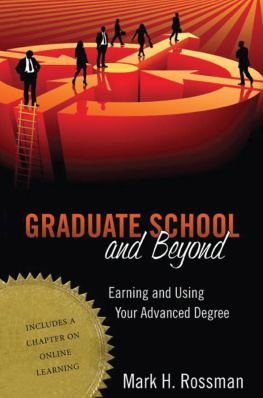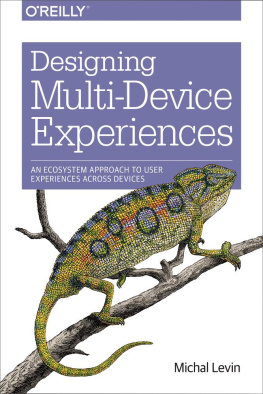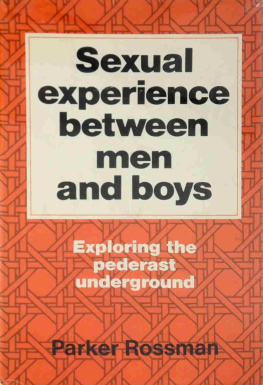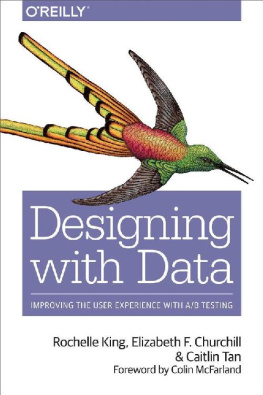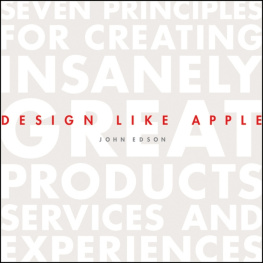Columbia University Press
Publishers Since 1893
New York Chichester, West Sussex
cup.columbia.edu
Copyright 2019 Columbia University Press
All rights reserved
E-ISBN 978-0-23154-951-6
Library of Congress Cataloging-in-Publication Data
Names: Rossman, J. Robert (James Robert), 1946- author. | Duerden, Mathew D., author.
Title: Designing experiences / J. Robert Rossman, Mathew D. Duerden.
Description: New York: Columbia University Press, [2019] | Includes bibliographical references and index.
Identifiers: LCCN 2019004424 (print) | LCCN 2018061290 (e-book) | ISBN 9780231191685 (cloth: alk. paper) | ISBN 9780231549516 (e-book)
Subjects: LCSH: Customer relations. | Customer services. | Experience. | Target marketing.
Classification: LCC HF5415.5 .R675 2019 (e-book) | LCC HF5415.5 (print) | DDC 658.5/038dc23
LC record available at https://lccn.loc.gov/2019004424
A Columbia University Press E-book.
CUP would be pleased to hear about your reading experience with this e-book at .
Cover design: Noah Arlow
Contents
PART ONE
Understanding Experience
CHAPTER ONE
Exploring Experiences and Experience Design
CHAPTER TWO
What Makes a Great Experience?
CHAPTER THREE
A Framework of Experience Types
PART TWO
The Experience Designers Toolkit
CHAPTER FOUR
The Experiencescape
CHAPTER FIVE
Experience Design Thinking
CHAPTER SIX
Designing the Experience Journey
CHAPTER SEVEN
Touchpoints and Transitions
PART THREE
Creating Great Experiences: Enhancements and Examples
CHAPTER EIGHT
The Stories We Tell: Building Drama in Your Experiences
CHAPTER NINE
Techniques for Enhancing Experiences
CHAPTER TEN
Using Experience Design in Product Development and Corporate Strategy
B. JOSEPH PINE II
I FIRST MET Mat Duerden in 2017 at the annual thinkAbout event that my partner Jim Gilmore and I had staged every year for the past twenty years. A couple of Brigham Young University colleagues had come the previous year, and one of them joined Mat at this, our final event in Cleveland. It was from Mat that we heard the news: thanks to their collective and concerted efforts, BYU had changed the name of their program from the Department of Recreation Management to the Department of Experience Design and Management! It is the first university in the United States I know of to fully recognize the importance of experience design and management.
And this book, by Mat and his colleague Bob Rossman, is the first I know of that is fully focused on putting forth a set of experience design ideas, principles, and frameworks that will, should you follow them, yield an intentionally designed and engagingly staged experience.
Now, truth be told, I am still looking forward to meeting the lead author, but based on what you will read here, I know Bob understands experience design. Interestingly, in the very first chapter where Bob and Mat discuss applying user experience design, customer experience design, and service experience design, I half-expected them to direct the reader to apply experience experience design, for that should be the focus: the design of the actual experience that people have. For as my partner Jim and I endeavored to make clear in our book The Experience Economy, experiences are a distinct economic offering, as distinct from services as services are from goods. Experiences use goods as props and services as the stage to engage each individual in an inherently personal way and thereby create a memory, the hallmark of the experience.
In guiding experience designers to make that a reality Bob and Mat focus on three factors I consider paramount in the field: being intentional, orchestrating elements, and designing time.
The authors introduce the concept of intentionality right up front. People have many experiences throughout life that are unplanned, and companies offer many experiences that are haphazardly designed or even totally unplanned. But to have any success in todays experience economy, you must be very intentional about what it is you are staging, about what you want your gueststhe customers of experiencesto undergo in order to engage them and create that memory.
Here the authors usefully apply the notions of micro- and macroexperiences, where the intentional design of the microexperiencesthe deliberate sequencing of engaging elementsadd up to the macroexperience encompassing the phases of anticipation (before), participation (during), and reflection (after). In The Experience Economy we discuss this intentionality at its highest level under the concept of an experience themethe organizing principle of the experience that lets you, as the designer, determine what is in the experience and what is out in order to stage a cohesive experience, one that hangs together across all the microexperiences to form, define, and sequence that macroexperience. (And as an aside, youve got to love a book that introduces as the masters of intentionality the proprietors of Buc-ees restroom experiences! But you have to be in Texas to truly appreciate them.)
You can see this focus on intentionality right in Mat and Bobs definition of experience design: the process of intentionally orchestrating experience elements to provide opportunities for participants to co-create and sustain interactions that lead to results desired by the participant and the designer. And right there, too, you see the second key factor mentioned earlier: orchestrating. Although Jim Gilmore and I tend to use the term stage, we have always understood that orchestrate and even choreograph fit as well, for they each describe how that intentionality results itself in the design of every aspect of the experience, from the environment to the positive cues arrayed in that environment (as well as the negative cues absent, sometimes conspicuously so), to what workers do to enable each guest to fully engage in each experience and create that memoryall of which Bob and Mat collectively and helpfully dub the experiencescape.
The third factor is the one I fully appreciated only years after our book was published in 1999namely, that experience design is fundamentally the design of time. Each microexperience takes up its own particular amount of time; orchestrating the length and sequence of the microexperiences builds them up over time, drawing guests through a timeline that finally yields the macroexperience; and doing all this intentionally generates the drama you want to createand bein the world.
In fact, I love that in the authors discuss dramatic structure and introduce the Freytag diagram, something we, too, added to the updated edition of The Experience Economy in 2011. For the Freytag diagramthe brainchild of nineteenth-century German performance theorist Gustav Freytagis something theater students learn to this day to understand and embrace drama. This framework leads you in designing time, to put together that sequence of events, one on top of the other, that rise in action, build up to the climax, and then come back down again as the experience draws to a close. Without drama, the sequence falls flat, without much of anything going on. Ah, but with drama, your intentionally designed experience fully engages each guest to leave the residue of memory within them. Drama is time well designed.

